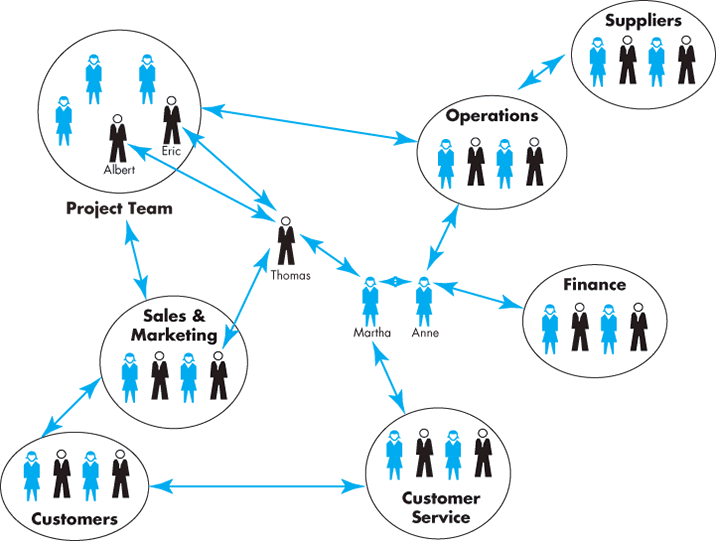Dependence: The Key to Power
The most important aspect of power is that it is a function of dependence. In this section, we show how understanding dependence helps us understand degrees of power.
The General Dependence Postulate
Let’s begin with a general postulate: The greater B’s dependence on A, the more power A has over B. When you possess anything others require that you alone control, you make them dependent on you, and therefore you gain power over them.6 As the old saying goes, “In the land of the blind, the one-eyed man is king!” But if something is plentiful, possessing it will not increase your power. Therefore, the more you can expand your own options, the less power you place in the hands of others. This explains why most organizations develop multiple suppliers rather than give their business to only one. It also explains why so many people aspire to financial independence. Independence reduces the power others can wield to limit our access to opportunities and resources.
What Creates Dependence?
Dependence increases when a resource you control is important, scarce, and nonsubstitutable.7
Importance
If nobody wants what you have, it’s not going to create dependence. However, note that there are many degrees of importance, from needing the resource for survival to wanting a resource that is in fashion or adds to convenience.
Scarcity
We see the scarcity-dependence relationship in the power situation of employment. When the supply of labor is low relative to demand, workers can negotiate compensation and benefits packages that are far more attractive than those in occupations with an abundance of candidates. For example, college administrators have no problem today finding English instructors since there is a high supply and low demand. The market for network systems analysts, in contrast, is comparatively tight, with demand high and supply limited. The resulting bargaining power of computer-engineering faculty allows them to negotiate higher salaries, lighter teaching loads, and other benefits.
Nonsubstitutability
The fewer viable substitutes for a resource, the more power a person controlling that resource has. At universities that value faculty publishing, for example, the more recognition the faculty member receives through publication, the more control that person has because other universities also want faculty who are highly published and visible.
Social Network Analysis: A Tool for Assessing Resources
One tool to assess the exchange of resources and dependencies within an organization is social network analysis.8 This method examines patterns of communication among organizational members to identify how information flows between them. Within a social network, or connections between people who share professional interests, each individual or group is called a node, and the links between nodes are called ties. When nodes communicate or exchange resources frequently, they are said to have very strong ties. Other nodes that are not engaged in direct communication with one another achieve resource flows through intermediary nodes. In other words, some nodes act as brokers between otherwise unconnected nodes. A graphical illustration of the associations among individuals in a social network is called a sociogram, which functions like an informal version of an organization chart. The difference is that a formal organization chart shows how authority is supposed to flow, whereas a sociogram shows how resources really flow in an organization. An example of a sociogram is shown in Exhibit 13-1.

Exhibit 13-1
Example of a Sociogram
![]() Networks can create substantial power dynamics. Those in the position of brokers tend to have more power because they can leverage the unique resources they can acquire from different groups. In other words, many people are dependent upon brokers, which gives the brokers more power. For example, organizational culture changes such as corporate social responsibility (CSR) awareness will often begin in a single connected group of individuals, grow in strength, and slowly move to other connected groups through brokers over time.9 Data from the United Kingdom’s National Health Service shows that change agents, people entrusted with helping an organization to make a significant change, have more success if they are information brokers.10 These functions are not without cost, however. One study found that people identified as central to advice networks were more likely to quit their jobs, possibly because they did a great deal of extra work without reward.11
Networks can create substantial power dynamics. Those in the position of brokers tend to have more power because they can leverage the unique resources they can acquire from different groups. In other words, many people are dependent upon brokers, which gives the brokers more power. For example, organizational culture changes such as corporate social responsibility (CSR) awareness will often begin in a single connected group of individuals, grow in strength, and slowly move to other connected groups through brokers over time.9 Data from the United Kingdom’s National Health Service shows that change agents, people entrusted with helping an organization to make a significant change, have more success if they are information brokers.10 These functions are not without cost, however. One study found that people identified as central to advice networks were more likely to quit their jobs, possibly because they did a great deal of extra work without reward.11
There are many ways to implement a social network analysis in an organization.12 Some organizations keep track of the flow of e-mail communications or document sharing across departments. These big data tools are an easy way to gather objective information about how individuals exchange information. Other organizations look at data from human resources (HR) information systems, analyzing how supervisors and subordinates interact with one another. These data sources can produce sociograms showing how resources and power flow. Leaders can then identify powerful brokers who exert the strongest influence on many groups, and address these key individuals.
